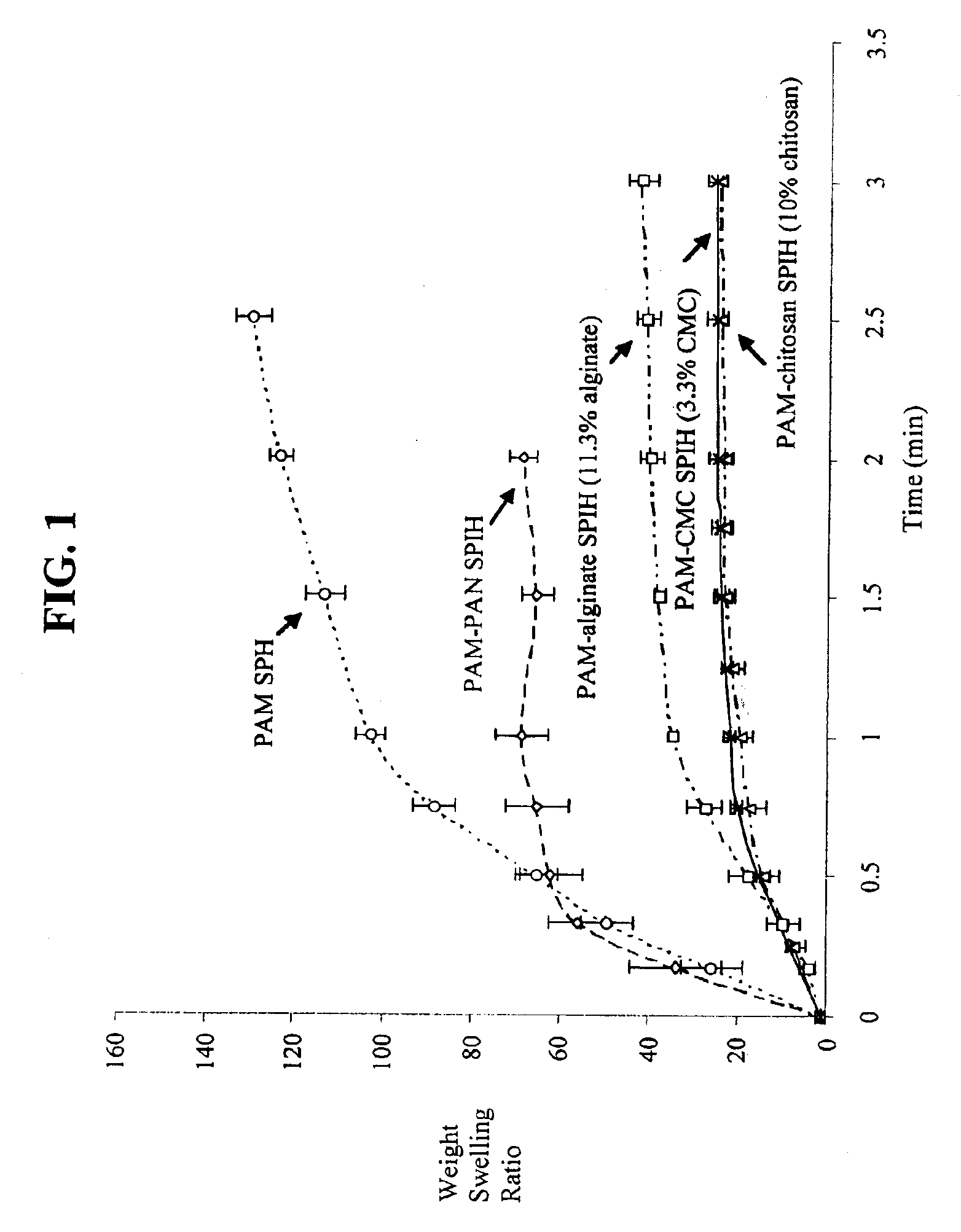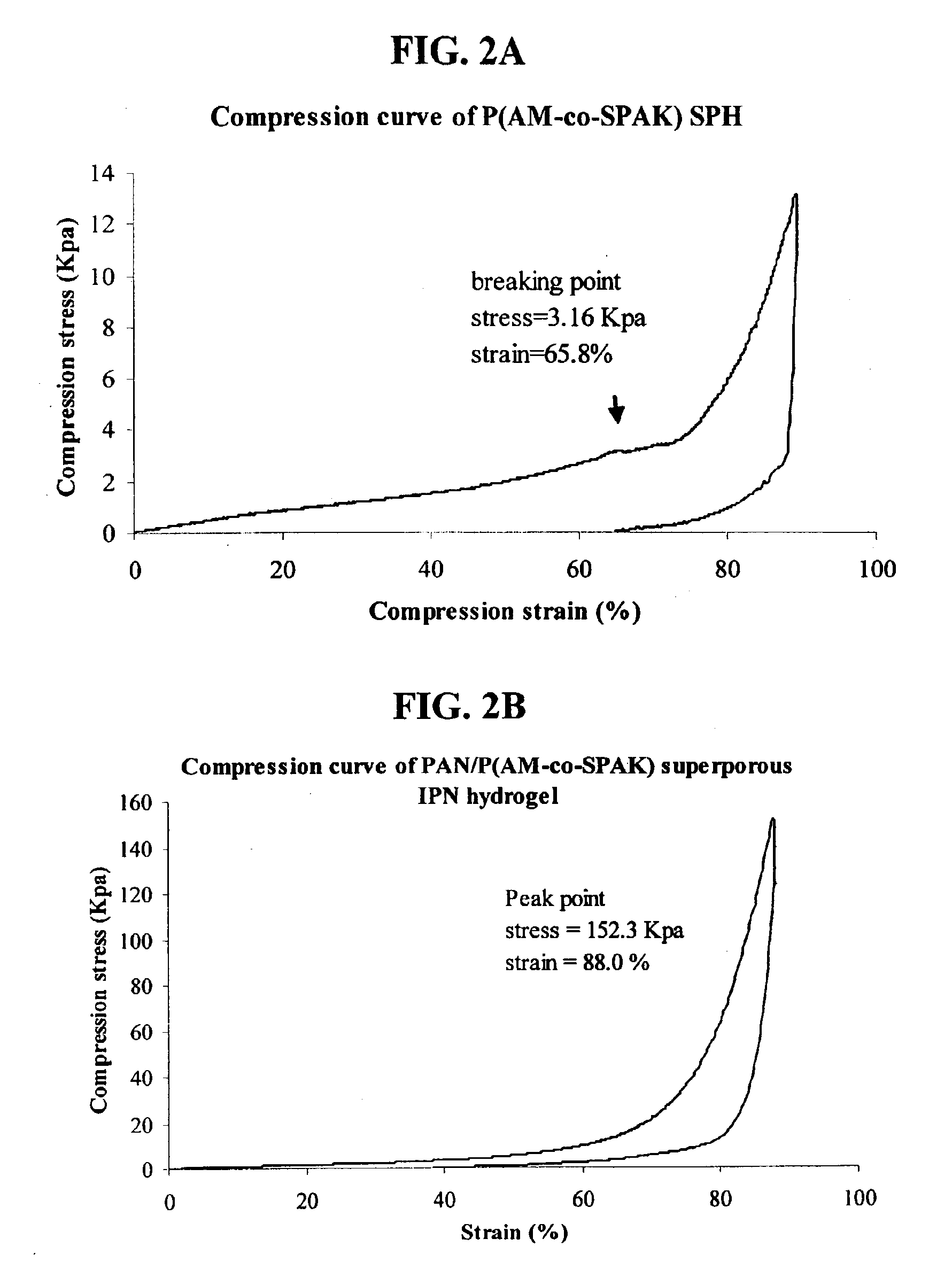Hydrogels having enhanced elasticity and mechanical strength properties
a technology of mechanical strength and hydrogel, which is applied in the field of hydrogels, hydrogel foams, and superporous hydrogels, can solve the problems of spihs and ihs generally having a very short swelling time, and achieve enhanced water absorption and mechanical strength properties, short swelling time, and great compression modulus
- Summary
- Abstract
- Description
- Claims
- Application Information
AI Technical Summary
Benefits of technology
Problems solved by technology
Method used
Image
Examples
examples
I. Conventional Copolymer-based SPHs
[0203]Conventional (unstrengthened) polymer-type SPHs (see U.S. Pat. No. 6,271,278) were prepared using two or more monomers to form the base hydrogel polymer. Variations in copolymer composition and the effects of synthetic method on swelling behavior and mechanical strength were examined.
example a
AAm-AAc-NaAAc(50:25:25)-BIS Copolymer.
[0204]The amount of 25 parts of monomer mixture composed of 50 w / v % acrylamide (AAm, Aldrich, Milwaukee, Wis.) and 50 w / w % acrylic acid (AAc, Aldrich) aqueous solution was mixed with 5.5 parts of 2.5 w / v % N,N′-methylenebisacrylamide (BIS, Aldrich) crosslinking agent, 2.5 parts of 10 w / v % Pluronic F127 (BASF, Gurnee, Ill.) foam stabilizer, and 1 part of 20 v / v % N,N,N′,N′-tetramethylethylenediamine (TMEDA, Aldrich) aqueous solution as reductant. The reactant stock solution was placed in a borosilicate glass culture tube (Coming, New York, N.Y.) with the dimensions of 10 mm (ID)×160 mm (L). The acid monomer was then partially neutralized to a pH of 5.1 by addition of 50 w / v % aqueous NaOH solution.
[0205]The polymerization reaction was initiated by adding 60 μl of 20 w / v % ammonium persulfate (APS, Aldrich) as the oxidant to the reaction mixture. The foaming reaction was triggered by addition of sodium bicarbonate (SBC, J. T. Baker, Phillipsbur...
example b
SPAK-AAc-NaAAc(50:25:25)-PEGDA Copolymer
[0207]The reaction in Example A was repeated substituting AAm with SPAK monomer and using a different crosslinker. An amount of acrylic acid aqueous solution was partially neutralized to the acrylate with NaOH solution to make a final pH of 5.3 and a final monomer concentration of 50% (v / v) of total acrylic acid and acrylate. The monomer mixture was combined with 60 μl Poly(ethylene glycol) diacrylate (PEGDA, F.W. 302) (crosslinker) dissolved in 1.85 ml of HEA. After the mixture became clear, 1.85 ml of 50% acetic acid (foaming agent) was added with stirring. Finally, 1.85 ml of 50% aqueous potassium salt of 3-sulfopropyl acrylate (SPAK) monomer was added dropwise to the monomer mixture with stirring.
[0208]The SPH was prepared in a plastic test tube (17 mm in diameter×100 mm in length) by mixing 0.56 ml of monomer mixture, 50 μl of 10% Pluronic F127, 30 μl of 20% TMEDA, 40 μl of 20% APS and water to make a final volume of 1 ml. The test tube w...
PUM
| Property | Measurement | Unit |
|---|---|---|
| pore size | aaaaa | aaaaa |
| pore size | aaaaa | aaaaa |
| tensile strength | aaaaa | aaaaa |
Abstract
Description
Claims
Application Information
 Login to View More
Login to View More - R&D
- Intellectual Property
- Life Sciences
- Materials
- Tech Scout
- Unparalleled Data Quality
- Higher Quality Content
- 60% Fewer Hallucinations
Browse by: Latest US Patents, China's latest patents, Technical Efficacy Thesaurus, Application Domain, Technology Topic, Popular Technical Reports.
© 2025 PatSnap. All rights reserved.Legal|Privacy policy|Modern Slavery Act Transparency Statement|Sitemap|About US| Contact US: help@patsnap.com



